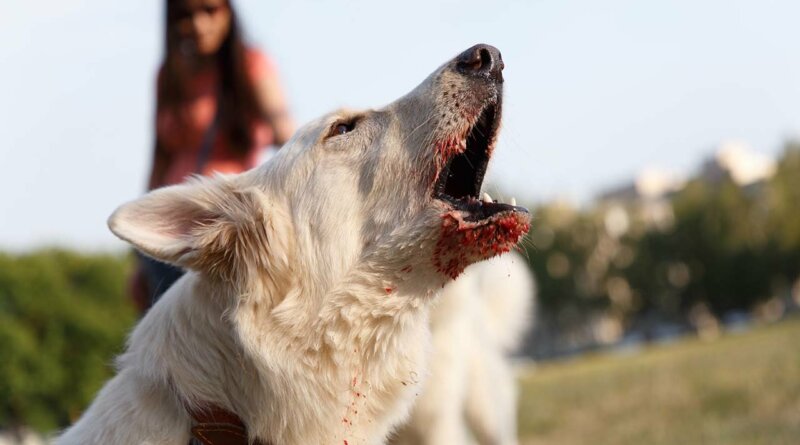My 6 Best Aggressive Dog Training Tips (And What You Should NOT Do)
[ad_1]
One of the most common behavioral reasons that pet owners seek veterinary care is a dog’s aggression. It is also the number one reason dogs are surrendered to or returned to animal shelters. Training an aggressive dog should not be done without the help of a professional dog trainer, but some of these aggressive dog training tips can help you.
It has been estimated that approximately 4.3 million people are bitten by dogs every year. You DO NOT want to add to this statistic. No matter how much you feel that you trust your dog, he cannot be fully trusted if he’s showing signs of aggression.
When it comes to your dog’s behavioral problems, in order to minimize the risks associated with an aggressive dog, it’s of utmost importance for pet owners to understand what exactly aggression in dogs means, its causes, and ways to avoid and modify aggressive behavior in dogs.
My 6 Best Aggressive Dog Training Tips
1. No Punishment, Ever
Aggressive dog or not, use positive reinforcement and positive reinforcement only. Use clear, strong commands that your dog is familiar with. Be calm and reassuring. Give the dog praise and positive reinforcement when your pup behaves properly.
For example: let’s say your dog is aggressive towards another animal in your home. When he chases, barks or growls at that animal, use a clear and strong command for him to “Stop!” or “Sit!” When a dog follows basic commands, reward him with a treat or praise.
Keep this up consistently and be authoritative. Establish your position in the eyes of your dog by being in charge and not rewarding the dog when he behaves badly. Although bribery and distraction are quick fixes, in the long run they teach your dog that doing naughty things will earn him a reward, further incentivizing the pet’s poor behavior.
When a situation appears where you expect your dog is going to be aggressive, immediately begin talking to him in a reassuring way. Give him treats and make the situation into something positive instead of negative.
Once the situation passes, stop petting, do not give any treats and stop talking comfortingly to your dog. He will eventually associate the stressful situation with a positive result, instead of something that requires his aggressive reaction.
2. Seek Professional Help
I cannot stress this enough: aggressive dogs can be dangerous and it’s not recommended that you attempt to re-train the dog just by yourself. While these dog training tips may be helpful, you’re still at risk of things going badly.
As it happened many times (some stories from Dr Jen), aggression in dogs can quickly lead to serious accidents. The best thing that you can do is seek the advice and help of a professional trainer, veterinarian and canine behaviorist.
Behavioral dog trainers are generally available in most areas, but normally they don’t all work with aggressive dogs. Be sure to call and chat with the trainer about your dog’s specific needs first, and provide more information.
3. Underlying Reason and/or Triggers
You should consult your veterinarian to see if there is some sort of psychological and/or medical cause behind your dog’s aggressive behavior. Medical issues are actually a common cause of aggression in dogs.
This is especially true if the aggressive behavior starts quickly or increases in intensity in a short period of time. Some medical conditions that have been proven to cause aggression include:
- hypothyroidism
- Cushing’s Disease
- mast cell cancer
- urinary tract infections
- hip and elbow dysplasia
- arthritis
Some types of aggression may also be neurological. In cases where medical issues or neurological problems are the cause of the aggression, training is not enough! Your veterinarian will set you up with a canine neurologist or a veterinary behaviorist that can help you diagnose and understand the issues.
4. Stay Calm, Speak Softly but Firmly
Research has shown that dogs can understand human emotions. They take cues from our voice and body language to determine how we are feeling. Have you ever noticed that your dog gets excited when you’re excited or sad when you are sad?
If you’re nervous when training an aggressive dog, he will sense that. If you’re angry or frustrated, he will sense that too. This could stress your dog even more, and cause him to act even more aggressively.
One of the best aggressive dog training tips is to stay calm. Speak in a normal tone and control your body language. If you feel yourself getting frustrated or anxious, take a break from the training until you can compose yourself.
5. Muzzles Are Beneficial
Dog muzzles are a controversial piece of training equipment, but they can be used for more than aggression only; you just need to know what you’re doing.
It is a common misconception that muzzles are only used to keep aggressive dogs from biting. On the contrary, muzzles for dogs can be used for many different types of training, and they’ve been proven to be quite effective.
Remember, a muzzle is not an acceptable alternative to socialization and proper training. If your dog is showing signs of aggression you need to work with a trained professional. You should not be training an aggressive dog without experience.
Muzzles have become known to many dog owners as inhumane, but that couldn’t be farther from the truth. Muzzles do not hurt the dog, and they can be used to even protect your dog, yourself and other people around you while you’re training.
If you’re trying to work with your pet around other animals or new people, a muzzle will make things easier and safer. Using a muzzle during these types of training exercises will allow you to be more relaxed, which will have a calming effect on your dog as well.
If something does go wrong and your dog reacts inappropriately, no one will get hurt because the dog’s been wearing a muzzle. This will give you peace of mind so you can be focused 100% on the aggressive dog training experience.
6. Desensitize SLOWLY
As with all types of dog training, desensitizing your dog to his aggression triggers will not happen quickly. It’s a process that must be done gradually. Forcing your dog to get used to triggers too quickly is likely to result in an aggressive incident that could hurt you, your pet or other humans/animals.
Take your time, be consistent and work with a professional trainer or behaviorist. An expert will help you understand what is causing the aggression, so you can get to the root of the problem.
READ NEXT: 15 Facts About Fear Aggression In Dogs You Must Know
[ad_2]
Source link






